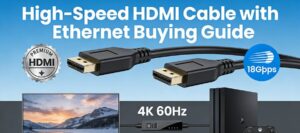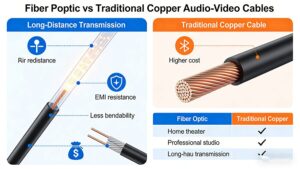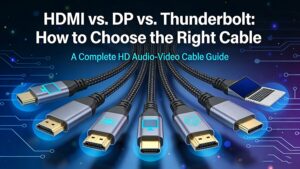En la era digital actual, en la que dependemos en gran medida de nuestros smartphones, tabletas, portátiles y otros dispositivos, es esencial contar con un cargador USB C fiable y eficiente. Con la proliferación de dispositivos con USB C, el mercado está inundado de cargadores, lo que dificulta la elección del más adecuado. Esta entrada del blog le guiará a través de los factores clave a tener en cuenta al seleccionar un cargador USB C para sus dispositivos.
USB C y sus ventajas
USB C, también conocido como USB Tipo - C, es un conector reversible que se ha hecho cada vez más popular en los últimos años. Ofrece varias ventajas con respecto a los conectores USB tradicionales:
- Carga más rápida: Los cargadores USB C pueden suministrar más potencia, lo que permite tiempos de carga más rápidos. Por ejemplo, algunos cargadores USB C pueden suministrar hasta 100 W de potencia, lo que permite cargar rápidamente un portátil o varios dispositivos a la vez.
- Transferencia de datos a alta velocidad: Los puertos USB C admiten velocidades de transferencia de datos de hasta 10 Gbps o incluso 40 Gbps en algunos casos. Esto lo hace ideal para transferir archivos de gran tamaño, como vídeos o copias de seguridad, en poco tiempo.
- Versatilidad: USB C puede utilizarse para cargar, transferir datos e incluso para salida de vídeo. Puedes conectar tu portátil a un monitor externo o a un televisor utilizando un Adaptador USB C a HDMIpor ejemplo.
Tenga en cuenta los requisitos de alimentación de su dispositivo
El primer paso para elegir el mejor cargador USB C es conocer los requisitos de potencia de su dispositivo. Los distintos dispositivos tienen necesidades de alimentación diferentes, y utilizar un cargador con una potencia de salida incorrecta puede provocar una carga lenta o incluso dañar el dispositivo. A continuación se muestra una tabla de referencia rápida para los tipos de dispositivos más comunes:
|
Tipo de dispositivo
|
Requisitos de potencia típicos
|
Dispositivos de ejemplo
|
|
Teléfonos inteligentes
|
18W - 120W
|
iPhone 15 (45 W), Samsung S24 (45 W), OnePlus 12 (100 W)
|
|
Tabletas
|
10W - 65W
|
iPad Pro (30 W), Samsung Tab S9 (45 W), Lenovo Tab P12 (65 W)
|
|
Portátiles
|
65W - 140W
|
MacBook Air (65 W), Dell XPS 13 (65 W), ASUS ROG Zephyrus (140 W)
|
Busque el protocolo de carga adecuado
Los protocolos de carga son los lenguajes que utilizan los cargadores y los dispositivos para comunicarse entre sí. Para garantizar una carga rápida y eficaz, el cargador y el dispositivo deben ser compatibles con el mismo protocolo de carga. Utiliza la tabla siguiente para hacer coincidir los protocolos con tus dispositivos:
|
Protocolo de carga
|
Características principales
|
Dispositivos compatibles
|
|
USB Power Delivery (PD)
|
Ajuste dinámico de la potencia, amplia compatibilidad
|
iPhones, iPads, MacBooks, la mayoría de teléfonos/portátiles Android
|
|
Carga rápida (QC)
|
Desarrollada por Qualcomm, la carga rápida para Android
|
Dispositivos Android con procesadores Qualcomm (por ejemplo, serie Samsung Galaxy S, Google Pixel).
|
|
Protocolos patentados
|
Marca - específica, velocidad máxima para dispositivos propios
|
Samsung Super Fast Charge (Galaxy), Huawei SuperCharge (serie Mate/P), Oppo VOOC (serie Find X)
|
Evaluar el número de puertos
Si tienes varios dispositivos con USB C, quizá te interese un cargador con varios puertos. Esto le permite cargar varios dispositivos simultáneamente, ahorrándole tiempo y molestias.
- Cargadores de un solo puerto: Los cargadores de puerto único son la opción más sencilla y compacta. Son ideales si sólo necesita cargar un aparato a la vez. Sin embargo, si tienes varios dispositivos, es posible que tengas que llevar varios cargadores, lo que puede resultar incómodo.
- Cargadores multipuerto: Los cargadores multipuerto suelen tener de 2 a 4 puertos, lo que permite cargar varios dispositivos a la vez. Algunos cargadores multipuerto pueden distribuir la potencia de forma inteligente entre los puertos, garantizando que cada dispositivo reciba la cantidad adecuada de energía para una carga rápida. Por ejemplo, un cargador multipuerto de 65 W puede suministrar 45 W a un portátil y 20 W a un smartphone cuando ambos están conectados.
Compruebe los dispositivos de seguridad
La seguridad debe ser siempre una prioridad a la hora de elegir un cargador USB C. Busca cargadores con funciones de seguridad integradas para proteger tus dispositivos de sobrecargas, sobrecalentamientos y cortocircuitos.
- Protección contra sobretensión: Esta función evita que el cargador suministre demasiada tensión al dispositivo, lo que podría dañar la batería u otros componentes.
- Protección contra sobrecorriente: La protección contra sobrecorriente garantiza que el cargador no suministre demasiada corriente al dispositivo, lo que también puede causar daños.
- Protección contra cortocircuitos: En caso de cortocircuito, el cargador corta automáticamente la alimentación para evitar daños en el aparato y en el propio cargador.
- Protección térmica: Los cargadores pueden calentarse durante el uso, especialmente cuando se cargan dispositivos de alta potencia. La protección térmica garantiza que el cargador se apague o reduzca la potencia de salida si se calienta demasiado, lo que evita el sobrecalentamiento y los posibles riesgos de incendio.
Considera la calidad de construcción y la portabilidad
- Portabilidad: Si se desplaza con frecuencia, la portabilidad es crucial. Busque cargadores que sean compactos y ligeros, para poder llevarlos fácilmente en el bolso o el bolsillo. Algunos cargadores vienen incluso con enchufes plegables, lo que reduce aún más su tamaño y los hace más cómodos de llevar.
En conclusión, elegir el mejor cargador USB C para tus dispositivos requiere tener en cuenta varios factores, como los requisitos de alimentación de tu dispositivo, el protocolo de carga, el número de puertos, las características de seguridad, la calidad de construcción y la portabilidad. Si te tomas el tiempo necesario para evaluar estos factores e investigas, podrás encontrar un cargador USB C que satisfaga tus necesidades y proporcione una carga rápida, eficiente y segura para tus dispositivos.







